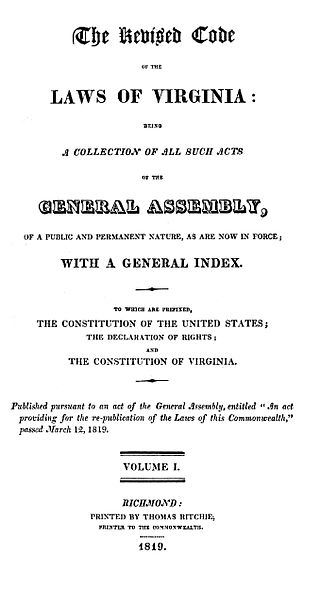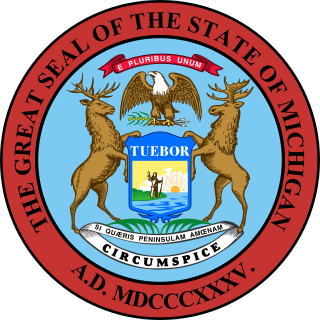Related Research Articles
The government of the U.S. state of Ohio consists of the executive, judicial, and legislative branches. Its basic structure is set forth in the Constitution and law of Ohio.
The statutes of the State of Ohio have established 26 departments of government which are responsible to the Governor. These departments are led by the Director, or in some cases the Commissioner, who must inform and assist the governor in the operation of the state. After the governor appoints the potential director, they must be affirmed by the Ohio Senate.
The Massachusetts General Laws is a codification of many of the statutes of the Commonwealth of Massachusetts. The Commonwealth's laws are promulgated by an elected bicameral ("two-chamber") legislative body, the Massachusetts General Court. The resulting laws—both Session Laws and General Laws—together make up the statutory law of the Commonwealth.

The Code of Virginia is the statutory law of the U.S. state of Virginia and consists of the codified legislation of the Virginia General Assembly. The 1950 Code of Virginia is the revision currently in force. The previous official versions were the Codes of 1819, 1849, 1887, and 1919, though other compilations had been printed privately as early as 1733, and other editions have been issued that were not designated full revisions of the code.
The law of Florida consists of several levels, including constitutional, statutory, and regulatory law, as well as case law and local law. The Florida Statutes form the general statutory law of Florida.

The Pennsylvania Bulletin is a weekly journal produced by the Commonwealth of Pennsylvania. Created on a weekly basis by staff in the Legislative Reference Bureau of Pennsylvania, which is housed at the Pennsylvania State Capitol building in Harrisburg, Pennsylvania, this publication serves as "the Commonwealth's official gazette for information and rulemaking" and is released for public consumption each Friday at 9 a.m. It lists the recent changes made to various agency rules and regulations within Pennsylvania's state government system and serves as a supplement to the Pennsylvania Code.
Edict of government is a technical term associated with the United States Copyright Office's guidelines and practices that comprehensively includes laws, which advises that such submissions will neither be accepted nor processed for copyright registration. It is based on the principle of public policy that citizens must have unrestrained access to the laws that govern them. Similar provisions occur in most, but not all, systems of copyright law; the main exceptions are in those copyright laws which have developed from English law, under which the copyright in laws rests with the Crown or the government.
The law of Colorado consists of several levels, including constitutional, statutory, regulatory, local, and case law. The Colorado Revised Statutes form the general statutory law.
The law of Virginia consists of several levels of legal rules, including constitutional, statutory, regulatory, case law, and local laws. The Code of Virginia contains the codified legislation that define the general statutory laws for the Commonwealth.

The law of New York consists of several levels, including constitutional, statutory, regulatory and case law, and also includes local laws, ordinances, and regulations. The Consolidated Laws form the general statutory law.
The law of Texas is derived from the Constitution of Texas and consists of several levels, including constitutional, statutory, regulatory law, as well as case law and local laws and regulations.
The law of Illinois consists of several levels, including constitutional, statutory, and regulatory law, as well as case law and local law. The Illinois Compiled Statutes (ILCS) form the general statutory law.
The law of Pennsylvania consists of several levels, including constitutional, statutory, regulatory and case law. The Pennsylvania Consolidated Statutes form the general statutory law.
The law of Ohio consists of several levels, including constitutional, statutory, and regulatory, local and common law. The Ohio Revised Code forms the general statutory law.
The law of the U.S. state of Georgia consists of several levels, including constitutional, statutory, and regulatory law, as well as case law and local law. The Official Code of Georgia Annotated forms the general statutory law.

The law of Michigan consists of several levels, including constitutional, statutory, regulatory and case law. The Michigan Compiled Laws form the general statutory law.
The law of North Carolina consists of several levels, including constitutional, statutory, regulatory, case law, and local law.
The law of New Jersey consists of several levels, including constitutional, statutory, regulatory, case law, and local law.
The law of Massachusetts consists of several levels, including constitutional, statutory, regulatory, case law, and local ordinances. The General Laws of Massachusetts form the general statutory law.
The law of Washington consists of several levels, including constitutional, statutory, regulatory and case law, as well as local ordinances. The Revised Code of Washington forms the general statutory law.
References
- ↑ Putnam, Melanie K.; Schaefgen, Susan M. (1997). Ohio Legal Research Guide . Wm. S. Hein Publishing. pp. 65–66. ISBN 1-57588-087-3. LCCN 96-16186.
- ↑ "Laws, Acts, and Legislation". Ohio General Assembly Legislative Information Systems. Archived from the original on 31 August 2013. Retrieved 13 September 2013.
- ↑ Putnam & Schaefgen 1997, p. 68.
- ↑ http://www.lexisnexis.com/infopro/zimmerman/disp.aspx?z=1794. URL accessed 15 September 2006.